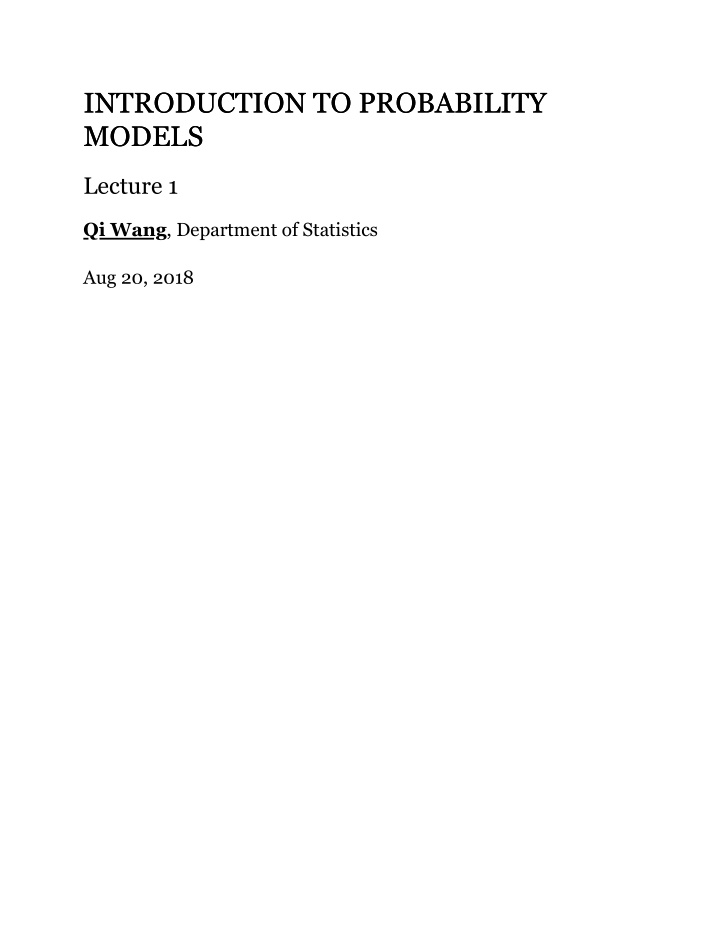



INTRODUCTION TO PROBABILITY INTRODUCTION TO PROBABILITY MODELS MODELS Lecture 1 Qi Wang , Department of Statistics Aug 20, 2018
ABOUT THE INSTRCUTOR ABOUT THE INSTRCUTOR Course Instructor: Qi Wang(Pronounced as Chee Waung) Email: qiwang@purdue.edu Homepage: http://www.stat.purdue.edu/~wang2047/ Office: MATH G143
SYLLABUS SYLLABUS
COURSE INFO COURSE INFO Textbook: Introduction to Probability by Mark Dan Ellen Gundlach, edition, W.H. Freeman Course website: http://www.stat.purdue.edu/~cfurtner/stat225 user name: stat225 password: fall2018 Session website : http://www.stat.purdue.edu/~wang2047/teaching/f
GRADING GRADING Homework 22.0% 125pts Quizzes 18.4% 105pts Exam 1 17.5% 100pts Exam 2 17.5% 100pts Final Exam 22.0% 125pts Class Participation 2.6% 15pts Total 100% 570pts
GRADES GRADES There will be NO curving of individual exam grades A student must earn a minimum of 60% on AT LEAST ONE of the 3 exams in order to pass this class.
QUIZ QUIZ 8 are scheduled Close book and close notes The lowest quiz will be dropped Make-up quiz Official documented University business or a documented illness Contact your instructor at least TWO DAYS in advance
HOMEWORK HOMEWORK 5 assignments Due at the begining of class Late homework will NOT be accepted Must be handwritten or typed using mathematical notation. Each homework is worth 25 points, NO homeworks are dropped.
EXAMS EXAMS Two evening exams from 8:00 -- 9:30 pm Exam 1: Tuesday, 9/25/2018 Exam 2: Tuesday, 10/30/2018 A final exam, during the day during final exam week Close book and close notes Items allowed pencils erasers a scientific calculator (must not have capability to do integration) one-page cheat sheet for mid-terms and two- page for the final Show a photo ID to your instructor
CHEAT SHEET CHEAT SHEET Handwritten in your own writing Both sides Handing in your cheat sheet at the end of the exam is required Use of printed or photocopied material on a cheat sheet is prohibited and considered cheating in this course
EMERGENCY EMERGENCY If you hear a fire alarm inside, proceed outside If you hear a siren outside, proceed inside Fire emergency: immediately suspend class, evacuate the building, and proceed outdoors do not use the elevator meet outside by fountain near John Purdue’s grave Tornado warning/servere weather event suspend class and shelter in interior hallway on floor Shelter in place suspend class and shelter in the classroom shutting the door and turning off the lights
A gambler's dispute in 1654 led to the creation of a mathematical theory of probability by two famous French mathematicians, Blaise Pascal and Pierre de Fermat
The game consisted in throwing a pair of dice 24 times, the problem was to decide whether or not to bet even money on the occurrence of at least one "double six" during the 24 throws
BASIC TERMINOLOGY BASIC TERMINOLOGY
BASIC TERMINOLOGY BASIC TERMINOLOGY This course is a course on Probability. The following terminology will assist us in the study of Probability.
Element: a single item(outcome), typically denoted by Set: a collection of elements For example, , x is a memeber of set A , j is not a smember of set B Population: the collection of all individuals or items under consideration Random Experiment: an action whose outcome cannot be predicted with certianty beforehand Sample Space: the set of all possible outcomes for a random experiment, typically denoted by , the textbook uses Event a result that may or may not occur, a subset of Subset: a set in which every element is contained in another set Notation: , A is a subset of B Complement: a set that contains all of the elements in that aren't in the original set Notation: is the complement of Empty Set: the set with no element in it, denoted by or
EXAMPLE 1 EXAMPLE 1 We check whether the Standard and Poor’s 500 Index at the end of the day shows an increase, a decrease or remains the same as the previous days ending index. 1. For one day, what is the sample space for this scenario? 2. What is the sample space for two days? 3. Define event A: the S & P decreases at least one day. List the outcomes in A. 4. What are the outcomes in the complement of A? 5. What do you notice if we combine A and its complement?
Recommend
More recommend